

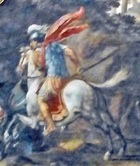
St Crescentian on horseback
Detail of panel (1747-9) by Marco Benefial
in which St Crescentian kills a dragon
Presbytery, Duomo
St Crescentian
An entry in the Roman Martyrology under 1st June reads: “At Città di Castello in Umbria, St Crescentian, a Roman soldier, crowned with martyrdom under [the Emperor Diocletian]”.
While the cult of St Crescentian is documented in liturgical literature from the 11th century, the surviving accounts of his life and martyrdom are much later:
-
✴The earliest known version of his legend, which was written in Urbino (see below), probably dates to the 14th century. The Bollandists published a version (BHL 1983) from a manuscript written at Urbino in 1567. It names the saint “Crescentianus, sive Crescentinus” (Crescentian or Crescentinus).
-
✴The earliest known version of a legend from Città di Castello was written by Canon Nicolò Manassei in ca. 1613, shortly after the translation of the head of St Crescentian to Città di Castello (see below).
BHL 1983 relates that St Crescentian was a Roman soldier who became a Christian. He fled from Rome along the Tiber to “agro Tiphurnati” (now Città di Castello). He evangelised the area and became famous when he killed a dragon there. This news reached the Emperor Diocletian, who ordered the Etrurian Prefect Flaccus to investigate. When St Crescentian refused to make a pagan sacrifice in the forum, Flaccus ordered that he should be beheaded. Some Christians retrieved his body and buried him in the Pieve di San Crescentino de’ Saddi (some 10 km from Città di Castello).
Despite the late dates of these legends, it is clear that the cult of St Crescentian flourished in Città di Castello and in the surrounding area from an early date:
-
✴The people of Saddi were documented as “plebs Sancti Crescentini” in 1077.
-
✴The Vita Floridi (BHL 3062), which was written in ca. 1077 by Canon Arnolfo of Arezzo, relates that, as St Floridus approached death (traditionally in 599), he moved with St Amantius to the Pieve de’ Saddi and built a house on the burial site of St Crescentian. He died there on 13th November.
-
✴Other early churches that are known to have been dedicated to St Crescentian include the following:
-
•The original Oratorio di San Crescentino at Morra (between Cortona and Città di Castello) was documented in 1126.
-
•The Pieve di San Crescentino, Cantiano is probably the church of this dedication that is documented in the life of St Ubaldus (BHL 8357), which was written in 1163.
The feast of St Crescentian was reconfirmed by the Congregation of Rites in 1609.
Francesco Lanzoni (referenced below) has suggested that this St Crescentian might well be a double for the saint of the same name who was martyred at Rome on 8th August.
Relics of St Crescentian
An altar in the crypt of the Pieve de’ Saddi marks the presumed burial site, and the place in which the relics of St Crescentian were originally preserved.
The legend BHL 1983 records that Bishop Fulcone of Città di Castello gave part of the relics of St Crescentian to Bishop Mainardo of Urbino for his city in 1068. An armed mob opposed the translation but it was thwarted when the party from Urbino that was carrying the relics was enveloped in fog. Bishop Mainardo then houseded the relics in the new Duomo that he had built inside the walls of Urbino. Bishop Francesco Brancaleoni officially recognised the relics at Urbino in 1360.
The head of St Crescentian remained at the Pieve de’ Saddi after the translation of the rest of the remains to Urbino. [Bishop Giulio Vitelli (died 1530) placed it into a reliquary at the Pieve de’ Saddi that bore his arms.]
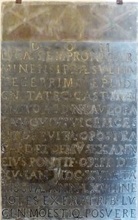
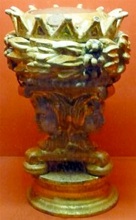
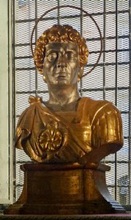
The relics at the Pieve de’ Saddi presumably gained in importance in 1609, when (as mentioned above) the feast of St Crescentian was reconfirmed by the Congregation of Rites. Evidence for this resurgence can be found in the chapel (the 1st chapel on the right) in the crypt of the Duomo, which dedicated to St Crescentian:
-
✴An inscription on the right wall records that Bishop Luca Semproni translated the head of St Crescentian to Città di Castello in 1613.
-
✴In fact, this first translation involved only part of the head: Bishop Evangelista Tornioli apparently translated other part to the city in 1628.
The chapel contains a reliquary (16th century) associated with these translations and a gilded wooden reliquary bust of the saint (which no longer contains a relic). A reliquary in Santa Maria delle Grazie (see below) is said to contain other relics of St Crescentian.
Iconography of St Crescentian
A relief (9th century) in the crypt of the Pieve di San Crescentino de’ Saddi (originally on the exterior) depicts St Crescentian on horseback killing a dragon.
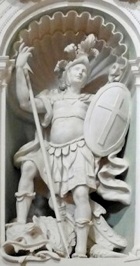
Martyrs of Saddi
In the literature relating to St Crescentian discussed above, he is always associated with a group of companions who were also martyred on 1st June and buried at Saddi:
-
✴St Virianus (or Verian);
-
✴St Justin;
-
✴St Grivicianus;
-
✴St Esuperantius;
-
✴St Benedict;
-
✴St Fortunatus;
-
✴St Eutropius;
-
✴St Faustinus; and
-
✴St Orphitus.
For example, the legend BHL 1983 lists the other martyrs (except St Faustinus) in the title, albeit that it does not otherwise refer to them. The relics of these saints were preserved at the Pieve de’ Saddi (see below), and their feast was celebrated on 1st June, along with that of St Crescentian.
There is no primary source for the lives of the Martyrs of Saddi. However, Pierluigi Licciardello (referenced below, at page 107) shows that almost all of them are listed among the companions in the legend of SS Felinus and Gratinian (BHL 3633), who were martyred in the reign of Decius at Perugia on 1st June: only St Crescentian himself and SS Eutropius and Orphitus are missing. (BHL 3633 was also apparently the source of one of the legends of St Florentius of Perugia).
Evidence for the cults some of the Martyrs of Saddi can be found in the dedications of early churches in the region. For example:
-
✴The Pieve di San Giustino, outside Città di Castello, was documented in 1009.
-
✴The Badia di San Veriano at Arezzo was documented in 1095.
-
✴The life of St Ubaldus (BHL 8357), which was written in 1163, records that he consecrated a church dedicated to St Orphitus.
Relics of the Martyrs of Saddi
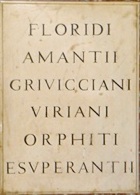
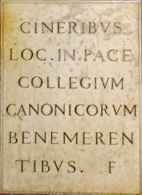
The inscriptions illustrated above, which is on the back of the Altare dei Corpi Santi in the crypt of the Duomo, list the saints whose relics were placed here by the canons of the Duomo in the 11th century: not only St Floridus and St Amantius, but also four of the Martyrs of Saddi:
-
✴St Grivicianus;
-
✴St Virianus;
-
✴St Orphitus; and
-
✴St Esuperantius.
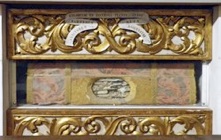
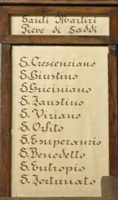
Monsignor Pompilio Mandrelli, the archpriest of Pietralunga in 1933-63, translated a reliquary from the Pieve de’ Saddi to Santa Maria delle Grazie. A list by the reliquary (in the 3rd bay on the left) claims that it contains relics of St Crescentian and of all the other martyrs of Saddi:
-
✴St Justin;
-
✴St Grivicianus;
-
✴St Faustinus;
-
✴St Virianus;
-
✴St Orphitus;
-
✴St Esuperantius;
-
✴St Benedict;
-
✴St Eutropius; and
-
✴St Fortunatus.
Read more:
Loris (L. Giacchi), “San Crescenziano da Tiferno”, (2003 ), Città di Castello
A. Czortek and P. Licciardello (Eds), “San Crescenziano di Città di Castello: Storia e Culto di un Martire dalle Origini all’ Età Modern”, Bollettino della Deputazione di Storia Patria per l' Umbria, 2 (2005) 5-252
See, in particular:
P. Licciardello, “Culto e Agiografia di San Crescenziano da Città di Castello a Urbino”, pp 91-168
F. Lanzoni, “Le Diocesi d'Italia dalle Origini al Principio del Secolo VII”, Faenza (1927) pp 482-3
Return to Saints of Città di Castello.

